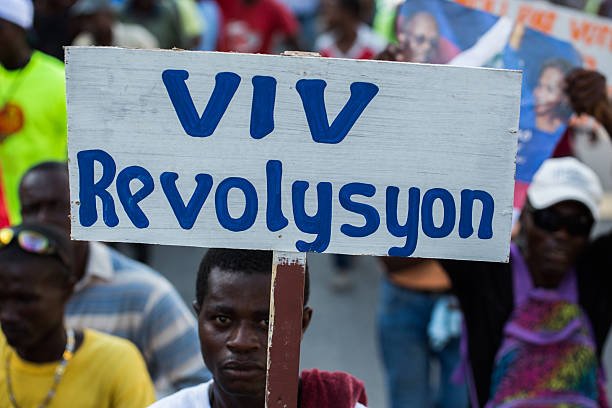Physical Address
304 North Cardinal St.
Dorchester Center, MA 02124
Physical Address
304 North Cardinal St.
Dorchester Center, MA 02124

Learn why Haiti's current chaos requires decisive population action that moves beyond gradual reform.
Haiti is facing an unprecedented crisis that has been exacerbated by years of gradual reform efforts that have not yielded the desired results. The situation demands a closer look at the need for decisive intervention.
The country’s ongoing challenges require a shift from traditional approaches to more decisive population action. It’s time to rethink the strategies that have been in place and consider new, innovative solutions to address the Haitian crisis effectively.
The current situation in Haiti is dire, with political instability, economic turmoil, and humanitarian crises reaching alarming levels. The nation’s stability is threatened by multiple factors, creating a complex emergency that requires a comprehensive understanding.
Haiti’s political landscape is marred by gang violence and a significant security breakdown. This has led to a governance vacuum, with failed leadership exacerbating the crisis.
Gangs have taken control of large areas of Port-au-Prince, leading to widespread violence and insecurity. The security breakdown has had a devastating impact on the population, with many forced to flee their homes.
The lack of effective governance has contributed to the crisis, with leadership failures at various levels hindering efforts to restore order and stability.
The economic situation in Haiti is grim, with poverty and food insecurity on the rise. Statistics indicate a worrying trend in poverty levels, further complicated by malnutrition.
Poverty in Haiti has reached critical levels, with a significant portion of the population living below the poverty line. Trends indicate a worsening situation without immediate intervention.
Food insecurity is rampant, leading to high rates of malnutrition among children and adults alike. This has long-term consequences for the health and well-being of the population.
The humanitarian situation is dire, with the healthcare system on the verge of collapse and significant displacement and migration patterns observed.
The healthcare infrastructure is severely strained, with many facilities unable to operate effectively due to the crisis.
Many Haitians have been forced to flee their homes, leading to significant displacement and migration. This has put additional pressure on already strained resources in neighbouring areas.
Since the end of the Duvalier regime, Haiti has seen multiple attempts at democratic transition and reform, but these efforts have been met with limited success. The country’s history is marked by a complex interplay of political instability, economic challenges, and social unrest.
The transition from authoritarian rule to democracy has been fraught with challenges. Democratic transitions in Haiti have often been followed by periods of instability and setbacks.
Haiti’s journey towards democracy has been characterized by elections, coups, and political stalemates. The fragility of democratic institutions has hindered the country’s ability to achieve lasting stability.
Constitutional reforms have been a key aspect of Haiti’s reform attempts, aiming to strengthen democratic governance. However, the implementation of these reforms has often been hampered by political gridlock and a lack of consensus.
International interventions, including UN peacekeeping missions, have played a significant role in Haiti’s recent history. While these interventions have had some successes, they have also faced significant challenges and criticisms.
UN peacekeeping missions in Haiti have contributed to periods of relative stability, but they have also been criticized for their limited impact on underlying structural issues and for incidents that have undermined their legitimacy.
The effectiveness of foreign aid in Haiti has been a subject of debate. While aid has provided crucial humanitarian assistance, concerns have been raised about its sustainability and the potential for dependency.
Despite numerous reform attempts and international interventions, Haiti continues to face significant challenges. The limitations of gradual reform and the pervasive issue of corruption have been major obstacles to lasting change.
Gradual reform efforts have often been criticized for being too slow or too superficial, failing to address the deep-seated structural issues that underpin Haiti’s crises.
Corruption remains a significant challenge in Haiti, with elites often capturing resources and hindering the equitable distribution of aid and development benefits.
The demographic reality in Haiti is one of rapid growth, high density, and significant youth unemployment, creating a complex web of challenges.
Haiti’s population is growing at a rate that is among the highest in the region. This growth is characterized by high birth rates and a relatively young population.
According to recent statistics, Haiti’s total fertility rate stands at approximately 3.2 children per woman, significantly higher than the global average. This high birth rate contributes to a rapidly expanding population.
Haiti is in the early stages of demographic transition, characterized by declining mortality rates but persistently high fertility rates. This transition phase puts additional pressure on the country’s resources and infrastructure.
The strain on Haiti’s resources is exacerbated by its high population density, particularly in urban centers.
As the population grows, the available land per capita decreases, leading to increased competition for this limited resource.
Port-au-Prince, the capital city, is one of the most densely populated urban areas in the Caribbean. Overcrowding here contributes to a range of social and environmental issues.
| Indicator | Value | Regional Average |
|---|---|---|
| Population Density (people/km²) | 412 | 320 |
| Urban Population (%) | 55 | 45 |
| Total Fertility Rate (children/woman) | 3.2 | 2.5 |
Haiti’s population is notably youthful, with a significant proportion under the age of 25. This demographic characteristic presents both opportunities and challenges.
The high proportion of young people in Haiti results in a high dependency ratio, placing a strain on the working-age population.
The economy faces significant challenges in creating enough jobs to absorb the growing workforce, leading to high unemployment rates among the youth.
The interplay between environmental degradation and population pressures in Haiti is complex, involving factors like deforestation, soil erosion, and climate vulnerability. As the population grows, the demand for natural resources increases, leading to environmental degradation.
Deforestation is a significant environmental issue in Haiti, driven by the need for agricultural land, fuelwood, and charcoal. This has led to severe soil erosion, reducing agricultural productivity.
Haiti has lost a significant portion of its forest cover over the decades. Historically, the country was heavily forested, but now it’s one of the most deforested countries in the world.
Soil erosion due to deforestation has significantly impacted agricultural productivity. The loss of topsoil reduces fertility, affecting crop yields and food security.
Water scarcity is another critical issue in Haiti, exacerbated by population growth and environmental degradation.
According to recent statistics, a significant portion of Haiti’s population lacks access to clean water, affecting health and well-being.
Dense settlements face significant sanitation challenges, with inadequate waste management systems contributing to environmental and health issues.
| Indicator | Statistic |
|---|---|
| Population with access to clean water | 58% |
| Population with adequate sanitation | 32% |
Haiti is highly vulnerable to climate-related disasters, including hurricanes and earthquakes, which are exacerbated by its dense population and environmental degradation.
The country has experienced devastating hurricanes and earthquakes, resulting in significant loss of life and infrastructure damage.
A large portion of Haiti’s population lives in high-risk areas, including flood-prone zones and landslide areas, increasing vulnerability to natural disasters.
Haiti’s ongoing crisis has exposed the inadequacies of gradual reform, necessitating a more decisive approach to address its burgeoning population challenges. The country’s situation demands a comprehensive analysis of the limitations of incremental approaches and the critical role of population dynamics in perpetuating the crisis.
Gradual reforms have historically fallen short in addressing Haiti’s deep-seated issues. The primary limitations include reform fatigue and diminishing returns, as well as time constraints in crises.
Incremental reforms often lead to reform fatigue, where the population becomes disillusioned with the slow pace of change. This disillusionment can result in diminishing returns, as the initial enthusiasm for reform wanes over time.
Haiti’s crisis situation demands immediate action, which gradual reforms often cannot provide. The time-sensitive nature of the crisis necessitates more rapid and decisive interventions to prevent further deterioration.
Population dynamics play a crucial role in Haiti’s crisis. Understanding the carrying capacity of the country and the demographic pressure on its institutions is essential.
A carrying capacity analysis reveals that Haiti is struggling to support its population. The country’s resources are overstretched, leading to significant challenges in providing for the basic needs of its citizens.
The demographic pressure on Haiti’s institutions is substantial. The country’s infrastructure, healthcare, and education systems are all under strain due to the rapidly growing population.
The situation in Haiti calls for decisive intervention. Understanding tipping points and system collapse theory, as well as examining precedents from other post-crisis nations, can inform this intervention.
Haiti is approaching a tipping point, beyond which the system may collapse entirely. Decisive action is necessary to prevent this collapse and stabilize the country.
Other nations that have faced similar crises have implemented successful population-focused interventions. Examining these precedents can provide valuable insights for Haiti’s situation.
Addressing Haiti’s crisis requires a multifaceted approach, with population-focused interventions being a critical component. By targeting the root causes of the country’s challenges, such interventions can help mitigate the chaos and pave the way for stability.
Improving access to family planning and reproductive health services is a crucial step in managing population growth. This can be achieved through:
Expanding contraception access programs can significantly reduce unplanned pregnancies, thereby slowing population growth. Programs that provide a range of contraceptive methods are particularly effective.
Integrating family planning services with maternal health care can improve health outcomes for both mothers and children. This approach ensures that women have access to necessary care during and after pregnancy.
Empowering women through education is a powerful tool for reducing population growth. Educated women are more likely to make informed decisions about their reproductive health.
Initiatives that promote girls’ education can have a lasting impact on population dynamics. By ensuring that girls have access to quality education, we can empower them to make choices that benefit their health, well-being, and economic prospects.
Providing economic opportunities for women is another key strategy. When women have the means to support themselves and their families, they are more likely to delay marriage and childbirth, contributing to slower population growth.

Economic incentives can play a significant role in encouraging families to have fewer children. By providing financial benefits, governments can influence family planning decisions.
Conditional cash transfer programs, which provide financial assistance to families who meet certain health and education criteria, have been successful in several countries. These programs can be tailored to encourage smaller family sizes.
Developing social security systems can also help reduce the economic motivations for having large families. When families feel secure in their old age, they are less likely to have many children as a form of social insurance.
| Intervention | Description | Potential Impact |
|---|---|---|
| Family Planning Services | Improving access to contraception and reproductive health care | Reduced unplanned pregnancies, slower population growth |
| Girls’ Education Initiatives | Promoting education for girls | Empowered women making informed reproductive choices |
| Economic Incentives | Providing financial benefits for smaller families | Reduced family sizes, improved economic stability |
“Investing in family planning and reproductive health is not just a moral imperative; it’s an economic one. By empowering women and reducing unplanned pregnancies, we can drive growth and stability.”
By implementing these population-focused interventions, Haiti can take significant steps towards addressing its crisis and building a more stable future.
The international community’s support is essential for Haiti’s recovery, requiring a balance between urgency and ethical implementation. As the nation grapples with political instability, economic collapse, and humanitarian emergencies, external aid can play a pivotal role in stabilizing the situation.
When providing international support, it’s crucial to strike a balance between addressing the urgent needs of the Haitian people and ensuring that interventions are ethically sound. This involves considering the potential long-term impacts of aid programs and avoiding measures that could exacerbate the crisis.
One key ethical consideration is the distinction between voluntary and coercive approaches to population management. Voluntary family planning programs, for instance, respect individual choice and autonomy, while coercive measures can violate human rights and dignity.
Cultural sensitivity is also paramount. Programs must be designed with an understanding of Haitian culture and values to ensure they are acceptable and effective. This might involve incorporating local perspectives into program design and implementation.
International donors play a significant role in supporting Haiti’s recovery efforts. Their contributions can help address immediate needs and support long-term development.
Donors must prioritize funding for initiatives that address the root causes of Haiti’s crisis, such as population growth and environmental degradation. Ensuring accountability in the use of funds is also crucial to maintaining trust and effectiveness.
Effective coordination among aid organizations is vital to avoid duplication of efforts and ensure a cohesive response to Haiti’s challenges. This can be achieved through regular communication and collaborative planning.
| Coordination Aspect | Benefits |
|---|---|
| Regular Communication | Enhances collaboration and reduces duplication of efforts |
| Collaborative Planning | Ensures a unified approach to addressing Haiti’s challenges |
| Information Sharing | Facilitates a comprehensive understanding of the crisis and response efforts |
It’s essential to avoid neocolonial approaches that undermine Haitian sovereignty and autonomy. Instead, international support should empower local leaders and communities.
Fostering Haitian leadership and ownership in recovery efforts is critical. This involves supporting local initiatives and ensuring that Haitians are at the forefront of decision-making processes.
Respecting Haiti’s sovereignty while addressing its crisis requires a delicate balance. International support should complement, rather than dictate, the nation’s recovery efforts.
To break the cycle of instability, Haiti needs integrated solutions that merge population policies with governance improvements, economic opportunities, and environmental conservation. This comprehensive approach is crucial for addressing the multifaceted challenges facing the nation.
Effective governance is the backbone of any successful reform effort. In Haiti, this involves:
Economic growth is vital for stability. Key strategies include:
Environmental degradation exacerbates Haiti’s challenges. Restoration efforts should focus on:
By integrating these strategies, Haiti can make significant strides towards stability and prosperity. 
The path forward requires commitment and collaboration among various stakeholders. By combining population action with governance reforms, economic development, and environmental restoration, Haiti can overcome its current challenges and build a more sustainable future.
Haiti’s journey towards stability and prosperity requires a multifaceted approach that addresses the root causes of its current crisis. As discussed, the country’s demographic reality, environmental degradation, and economic challenges are deeply intertwined.
A path forward for Haiti involves implementing decisive population action, including family planning and reproductive health services, education, and women’s empowerment. These measures can help mitigate the pressures on the country’s resources and infrastructure.
International support is crucial in this endeavour, but it must be balanced with ethical considerations to avoid neocolonial approaches. A comprehensive strategy that combines population action with governance reforms, economic development, and environmental restoration can help Haiti break the cycle of instability.
By adopting an integrated approach, Haiti can unlock its potential for growth and development, ultimately creating a more stable and prosperous future for its citizens. The journey ahead will be challenging, but with the right support and commitment, Haiti can overcome its current challenges and forge a brighter path forward.